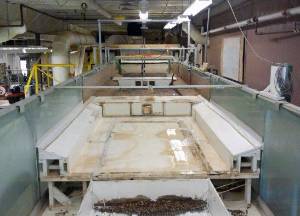Project 0-6549
Hydraulic Performance of Staggered-Barrel Culverts for Stream Crossing
Abstract
Literature interpretation, laboratory experimentation, and data analysis was used to infer guidelines to assist in assessing multiple barrel staggered-systems that mimic natural stream behavior to facilitate solids migration, yet still provide the sufficient clear-water hydraulic capacity to meet their transportation infrastructure drainage needs. A database developed from literature data pertaining to solids transport was developed along with a screening tool for estimating solids transport. The laboratory study examined staggered barrel and conventional culverts both in-line with the stream axis and skew to that axis to develop tools to predict culvert performance. Experiments showed culvert open area was correlated with solids transport while culvert shape was not. Staggered systems showed some advantage in skew-settings performing slightly better than anticipated based on in-line studies. Stage-conveyance plots showed that our largest open area systems to have a curve closest to the approach section stage-conveyence until submergence; a finding supportive of matching the approach section conveyance and the culvert system conveyance to maintain solids continuity through the system. Examples illustrating the screening tool on selected experiments are presented, as are suggestions for future study.

Project PI: Theodore G. Cleveland
Research Assistants:
Jeremy Kight
Wade Barnes
Student Assistants:
Dakota McDonald
Hiron Fernando
Jake Blessen
Jake Irvin
Kirsten Singleton
Marla Mauricio
Mert Bildiren
Michael Bassila
Kevin Nix
Nicole Frantz
Randall Franks
Steven Wolf
Zeferino Mendoza
Blak Rupard
Chelcie Babin
Clark Obermiller
Annabell Ulary
Center for Multidisciplinary Research in Transportation (TechMRT)
-
Address
Texas Tech University, Box 41023, Lubbock, TX 79409-1023 -
Phone
806.742.3523 -
Email
techmrt.outreach@ttu.edu
